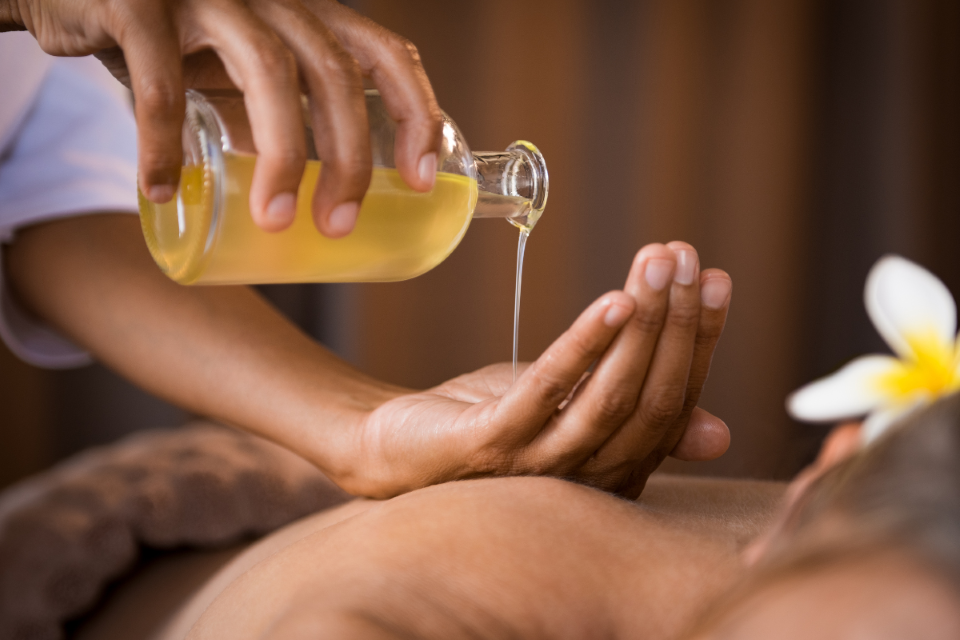What is Ayurvedic massage?
Ayurveda, India’s old system of healing has long recognized the many advantages of massage and used numerous forms of massage as part of both palliative (Shamana) and purificatory (Shodhana) treatments. Intentional touch, guided by the principles of Ayurveda has enormous power to return both body and mind to a joyous state of health and wellbeing.
The numerous strategies and considerations of Ayurvedic massage therapy that we will certainly explore have been laid out in lots of vedic messages consisting of the brhat trayi (the great three messages consisting of Caraka, Sushruta and Vagbhata) as well as Bhavaprakasha and Yogaratnakara. In old times, these methods were utilized for numerous factors including to support warriors and athletes, for the objectives of virilization and obviously for recovery such as in postpartum treatment and for preventative purposes.
Basic principles of the 5 aspects and three doshas in Ayurveda
Ayurveda recognizes that all matter is composed of the five great aspects; space, air, fire, water and earth.Join Us https://massage-valencia.com/en/masaje-ayurveda/ website When these five standard aspects show up in the body, the elements are grouped into 3 doshas. The doshas, additionally referred to as the three essential principles of Ayurveda are Vata which is made up of room and air, Pitta which is composed of fire and water and Kapha which is water and earth elements incorporated. All Ayurvedic therapy is based upon treating the doshas that get increased or vitiated, with their opposite high qualities.
Individualized treatment:
Ayurvedic massage therapies, like all other Ayurvedic treatments, are tailored to fit the needs of the specific recipient. Variables such as the individual’s special constitution (Prakruti) and current state of inequality of the doshas (Vikruti) educate choices made by the professional when preparing and executing a therapy. Various other important considerations are the state of the individual’s digestive system fire (Agni) and level of contaminants in the body (Ama).
The option of which Ayurvedic massage therapy methods to employ; whether they should be extra promoting or calming to the system, affects and cancels different doshas; as an example Vata and Pitta conditions can benefit from mild, smooth and soothing strokes, whereas Kapha problems can take advantage of even more heat being generated, stimulation and an increase in circulation.
One more vital factor is the option of oil with both the base or service provider oil and herbs that are instilled into the base being utilized intentionally to reduce certain doshic inequalities. Sesame oil, with its hefty and heating top qualities functions well to soothe Vata dosha, cooling down coconut or sunflower oil job well for Pitta, and lighter, home heating oils such as mustard can be utilized in Kapha problems.
For a Vata individual or condition, huge amounts of oil would certainly be utilized, for Pitta a modest amount of oil and for Kapha a small amount of oil.
When there is a considerable amount of Ama in the body, massage with oil is contraindicated due to the reality that many oils, having similar heavy, sticky and unctuous qualities as Ama itself, can worsen those conditions. Dry scrubing with herbal powders, also called Udvartana, might be employed rather in these instances.
In this way, we can begin to value how in Ayurvedic massage every aspect of the treatment, from the massage strokes to the choice of oil or herbs can be tailored and targeted to remedy the here and now imbalance by Ayurveda’s timeless like-increases-like’ viewpoint.
Unique considerations for Vata and the mind
According to Samkhya philosophy, the air component is connected with the sense of touch (Sparshendriya). Vata dosha, being made up of the air and space elements, is especially affected and pacified by touch. The mind, being associated with all the aspects however especially the subtlest air and room elements, can additionally particularly take advantage of healing touch. Thus, ayurvedic massage therapy is particularly valuable in the therapy of Vata dosha and psychological wellness issues.
That being stated, the customizable aspect of Ayurvedic healing massage will additionally provide itself well to supporting Kapha and Pitta worries, especially with reference to circulation and complexion problems respectively. Much of the physical structure and feature of the skin (Tvak) is regulated by bhrajaka pitta, responsible for the color, complexion and luster of the body’s largest body organ. Oil and herbs in the form of pastes or directly infused to those oils are said to nurture the agni of the skin, just as food nourishes our interior food digestion. By feeding the skin in this way, repetitively or regularly, these compounds will pass through to the much deeper tissues, consisting of the nerves, muscles, bones and organs as well as boost the high quality and durability of the skin itself.
Classifications of massage therapy:
Abhyanga
Possibly the most well known of Ayurvedic massage therapy methods, Abhyanga describes the technique of oiling the body. It can be exercised on one’s own body (self-massage) or offered as a treatment by one and even 2 practitioners for a four-handed massage therapy. As talked about, when applied topically, herbalized oils carry the medicinal residential properties of natural herbs right into the skin and deeper cells to unfold healing. The method of exterior oleation is accompanied by interior oleation in deep cleansing treatments such as Panchakarma to loosen up toxic substances and release the doshas that have gathered in the body.
Snehan’ in Sanskrit means both oil and love. Oil is the physical symptom of love and oil massage amounts balancing the cells of the body with a vibration of love and luster. Generally speaking, except in cases of high Ama and Kapha, oil is a main tenet of Ayurvedic massage. There are numerous unique herbalized oil formulations in Ayurveda such as Mahanarayan tailam, utilized specifically suffering conditions and Dhanvantaram tailam, named after the god of Ayurveda, Dhanvantari, among the most effective oils for Vata pacification.
Massage therapy with powders and pastes
Udvartana, or massage with completely dry and warm natural powders can be specifically valuable in relieving Vata and Kapha problems. Udsadana refers to this sort of massage therapy with dry natural herbs and is useful for cosmetic and improvement procedures and udgarshana, massage with organic pastes (herbs mixed with water or oil) works in minimizing other skin problem.
Extra categories of ayurvedic massage are named according to body area; Deha samvahana or deha mardana are terms made use of to define massage of the whole body, while head massage is called kesha mardana.

